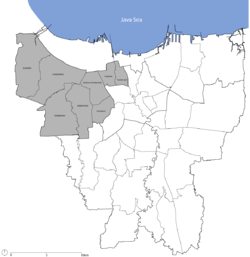Glodok
Glodok
裹踱刻 Golodog | |
|---|---|
 Chinatown gate in Mangga Dua | |
 Taman Sari is the western-most district |
Glodok (Chinese: 裹踱刻; pinyin: guǒ duó kè; Pe̍h-ōe-jī: kó tho̍h khek) is an administrative village of Taman Sari, West Jakarta, Indonesia. The area is also known as Pecinan or Chinatown since the Dutch colonial era, and is considered the biggest in Indonesia. Majority of the traders and residents of Glodok are Chinese descent. The area dates back to colonial times when in November 1740, Dutch East Indies Company (VOC) designated Glodok as a residential area for ethnic Chinese. Administratively, the area is a kelurahan under the Taman Sari subdistrict, West Jakarta.[1]
One of the biggest trading center for electronic goods in Jakarta is located within the area now.
History

Toponomy
The word Glodok came from the Sundanese word "Golodog", meaning entrance to a house, as Sunda Kalapa (Jakarta) is the gateway to the ancient Sundanese Kingdom. It was also thought that the name came from the "grojok grojok" sound that water makes coming out of a waterspout in the yard of the Cityhall (Stadhuis), now the Jakarta Museum. A waterspout was built on this site in 1743 and was used for daily needs such as a watering hole for horses.[2]
Early history
In Batavia (now Jakarta), Dutch East India Company created commercial opportunities which attracted immigrants from many areas of what is now Indonesia. This economic activity also lured thousands of Chinese people to Java. Swift immigration challenged the city's limited infrastructure and created burdens on the city. Tensions grew as the colonial government tried to restrict Chinese migration through deportations.
Glodok and Jakarta Riots
On 9 October 1740, 5,000 Chinese were massacred and the following year, Chinese inhabitants were ghettoized in Glodok outside the city walls.[3] In 1998, Glodok was badly scarred during rioting. Because some "Pribumi" Indonesians accused Chinese Indonesians of hoarding the nation's wealth, and because of the large concentration of Chinese Indonesians residing there, Glodok also suffered severe violence during the Jakarta Riots of May 1998. In 2006, practitioners of Falun Gong were reportedly "assaulted" during a meditation session. A Falun Gong representative suggested that the assailants were sent by the Chinese embassy, though a local news organization noted another possible motivation: that Falun Gong practitioners had been "disrupting business" by distributing pamphlets.[4]
Attractions





Chinatown
As for shopping centre, most of the vendors in Glodok are Chinese Indonesian. Glodok is the biggest Chinatown area in Indonesia, and one of the biggest Chinatowns in the world. China town covers three main areas, namely Gang Gloria (Gloria alley), Jalan Pancoran and Petak Sembilan. The Chinese came to Jakarta since the 17th century as traders and labourers. Most of them came from Fujian and Guangdong provinces in southern China. Centred on Pintu Besar Selatan Road, it has become a commercial hub for the relatively prosperous Chinese community. Assimilation between Chinese and pribumi made a language known as Betawi language.[5]Chinese New Year celebrations and Cap Go Meh celebrations held in the area is attraction. The area is now a spot to buy Chinese food, traditional Chinese medicine and cheap electronic goods.
Shopping
Glodok and contiguous of Mangga Dua[6] are one of the biggest shopping centres in Southeast Asia. It stretches from Pancoran street to Gunung Sahari street and has approximately 500,000 m2 of shopping centres. Beside sale of electronic consumer goods, Glodok is the biggest market for CD and DVD cassettes. Some of the shopping centers in this area are,
- Harco Glodok
- Orion Plaza
- Glodok Plaza
- Glodok Makmur
- Glodok Brustru
- Metro Glodok
- Hwi Lindeteves
- Lindeteves Trade Centre
- Pasar Pagi market
Culinary
Other than shopping, Glodok is a spot to buy Chinese food, traditional Chinese medicine and cheap electronic goods. Gang Gloria is a famous place for a wide array of dishes, including gado-gado (mixed vegetables served with peanut sauce), soto betawi (beef cooked in coconut milk), ketupat sayur (rice cakes served with coconut milk and vegetables), sek ba (pork offal stewed in soy sauce) and more. Established in 1927, the legendary Kopi Es Tak Kie coffee shop specializes in iced coffee. Rujak Shanghai Encim (boiled cuttlefish, radish, cucumber, and water spinach with red sauce and peanut sprinkle) this fresh salad was established around 1950s. This kind of dish is very rare, and only able find it at Glodok. [7]
Temples and church
There are three temples in the area, namely Dharma Bhakti Temple, Dharma Sakti Temple and Hui Tek Bio temple. Dharma Bhakti temple, which was esatablished in 1650 is the oldest temple in Jakarta.[8] Santa de Fatima Catholic Church, which is built in Chinese architecture located at Jl. Kemurnian III.
Transport
There are many bus services provided by TransJakarta, PPD, Mayasari Bakti, and city transport. TransJakarta stops at the Glodok bus stop. Visitors can also travel to Glodok by taxi and KRL Jabotabek. The rail system stops at the Jakarta Kota Station, 200 metres north of the market. Bicycles or Ojek Sepeda are also common transport in Glodok.
See also
External links
References
- ^ "Disinggung Sandiaga Uno, Ini Asal-usul Kawasan Pecinan Glodok". Kompas. Retrieved 9 October 2018.
- ^ Dari ”Grojok” Menjadi Glodok[permanent dead link]
- ^ Witton, Patrick (2003). Indonesia. Melbourne: Lonely Planet. pp. 138–139. ISBN 1-74059-154-2.
- ^ Falun Gong in Jakarta - Indonesia Matters
- ^ "Hikayat Kawasan Petak Sembilan". CNN Indonesia. Retrieved 9 October 2018.
- ^ "Mangga Dua shopping center".
- ^ "The glorious culinary gem of Gang Gloria in Glodok". The Jakarta Post. Retrieved 2017-08-11.
- ^ "Jakpost guide to Glodok". The Jakarta Post. Retrieved 2017-08-11.
